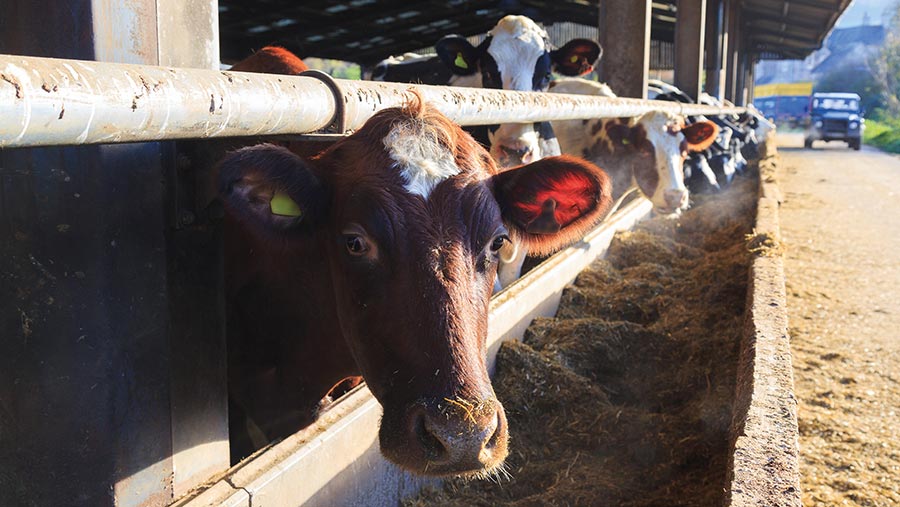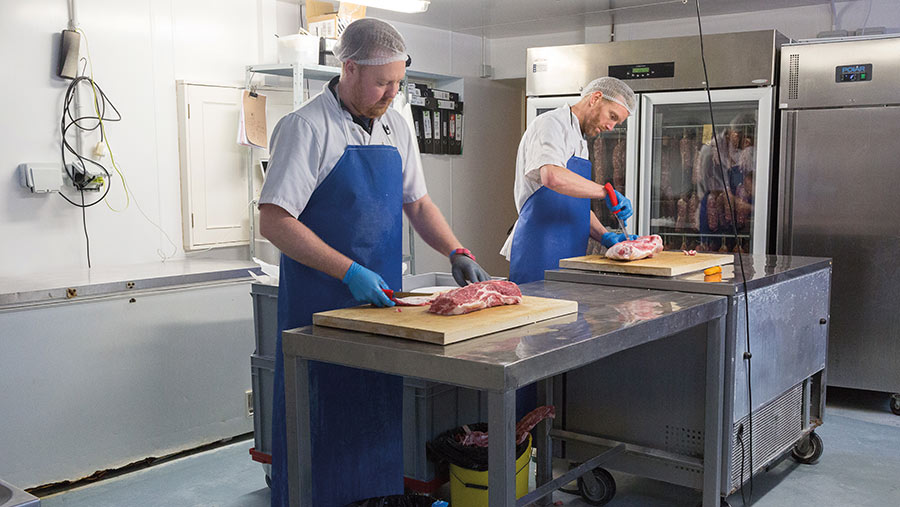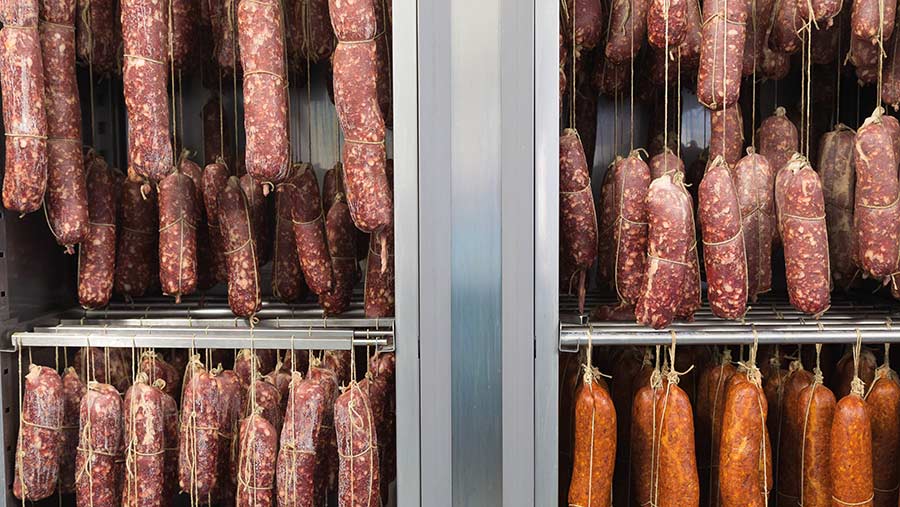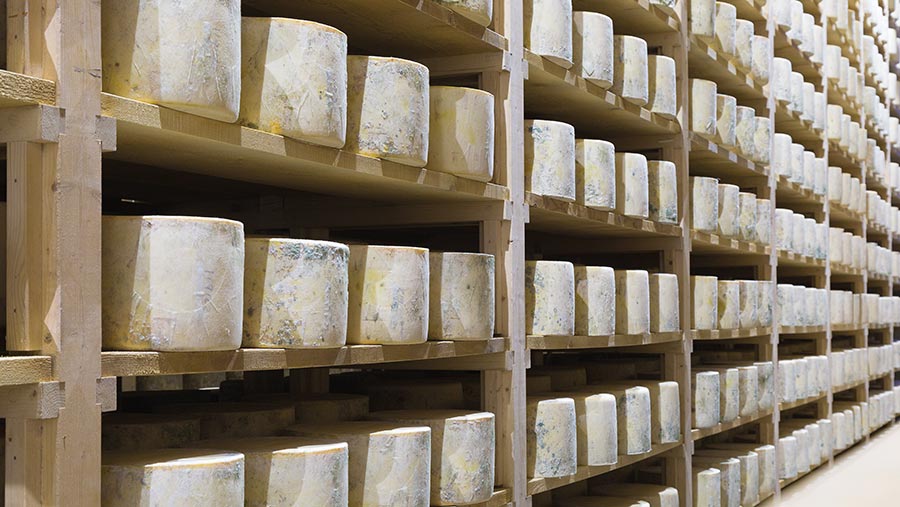How a Somerset farm is adding value to dairy bull calves
 © MAG/Judith Tooth
© MAG/Judith Tooth Father-and-son team Richard and Tom Calver have already built a name for Westcombe Cheddar, the raw milk cheese they produce from their two dairy herds.
Now, they are adding value to dairy bull calves by rearing them to produce charcuterie.
With a wide range of established customers for their cheese, they are in a good position to expand. At the same time, they are creating a new market for a part of dairy production that is often regarded as worthless.
See also: 7 top tips on establishing herbal leys
Farm Facts – Milton-Westcombe Farms
- Two mainly autumn-calving dairy herds, one with 200 cows, one with 170
- Annual yield just under 9,000 litres
- Conception rate to first service 53%
- Twice-a-day milking in herringbone parlours
- Paddock-grazing system
- Dairy-beef calves supplied to Buitelaar (Beef Shorthorn and Angus)
- Dairy bull calves reared on farm to produce charcuterie
- Producing 100-120t traditional cheddar a year, plus Caerphilly, ricotta and smoked cheese
- Cheese production uses just under half the farm’s milk – the rest is supplied to Barber’s
The idea came about because the farm, near Shepton Mallet, had started supplying other producers with starter cultures that are used in cheesemaking and charcuterie production (to start meat fermenting).
This was part of a business, previously run from the farm by a maker of Caerphilly cheese, which the Calvers had subsequently taken over.
“We thought, if we’re selling cultures to make cheese and charcuterie, we should know more about them,” says Tom.
Meanwhile, an hour away at Cannington, near Bridgwater, farmer Fred Price was looking for a grass break in his arable rotation.
With no cattle experience, but some knowledge of pigs, he decided to graze Tamworth-cross pigs on herbal leys.
“This gave us the idea of rearing calves to make veal salami using fat from Fred’s pigs. So, we made some [charcuterie], and it went really well,” says Tom.
Beef fat is quite granular, whereas pork fat is smooth, making it more suitable for salami production.
Age at slaughter

Westcombe Dairy butchers
Management of the calves is the same as those kept as herd replacements – they are out to graze from February or March on the farm’s steeper and less accessible fields.
A deliberately wide age profile for slaughter is maintained, between seven and 12 months, to ensure a steady supply for charcuterie production.
“We can also use calves that, for whatever reason, are not fitting in, for example, freemartins,” says Richard.
This provides a very useful alternative outlet – so if one of the herds is down with TB, the calves can be used for veal, he adds.
Bristol Veterinary School’s small abattoir at Langford has proved ideal for the animals to be slaughtered locally.
Carcasses are brought back to the farm, where charcuterie production manager Paul Burton and butcher Paul MacEnri prepare whole muscle cuts for products such as air-dried hams.
They break the remaining meat down into tissue types and recombine it to make salamis.
Adding value

Westcombe Dairy salami © MAG/Judith Tooth
They combine a little over 50% pork and a little under 50% veal to make a range of salamis that include saucisson sec, finocchiona – a traditional Tuscan salami flavoured with fennel seeds – and sobresada, a spreadable chorizo made using a recipe from the Balearic Islands.
These are aged for six weeks in a proving cabinet to preserve them gradually.
“By producing charcuterie from veal, we’re being honest about what it takes to produce milk and communicating that to our customers,” says Tom.
To produce a slightly stockier calf for the charcuterie, Dairy Shorthorn genetics are being introduced to the farm’s two Holstein dairy herds.
“It’s not so much a traditional Shorthorn – there is a degree of Holstein there. We don’t want to sacrifice too much yield,” says Richard.
Grazing management
The farm has moved to a more regenerative approach, spurred on by a desire to embrace as much diversity as possible across the business, from soils to customers.
As part of this, pasture management has moved from set-stocking to paddock grazing, and from traditional leys to herbal leys.
“We did a few experiments about five years ago – we tried herbal leys with set-stocking, but that didn’t work as the cows were defoliating the plants all the time,” says Richard. “They [the leys] need to rest.”
Paddock grazing was introduced successfully in one herd last year and was rolled out to the second herd this year, using herbal leys of up to 16 species with a range of rooting depths. The grazing rotation includes rest periods of 19-28 days.
“There was a lot of scepticism on our part,” says Tom, who was unsure whether the cows would even eat the herbal leys. “But the cows themselves seem to have changed their grazing palate – they even eat docks now.”
Funding for tracks and water troughs came via the farm’s Countryside Stewardship agreement.
However, the Calvers paid for fencing and pipework themselves, as they thought the specifications under the scheme were too high. Richard believes in picking up funding where you can, but not “farming to grant”.
Trees and shrubs have been planted along some of the new fence lines to provide shade for the cows in future years.
Silage production
Richard was, he says, very much an “ICI Nitram farmer” early in his farming career. This year, the farm used less fertiliser than ever – 25t across 243ha (600 acres) of mixed cropping.
A mix of Westerwolds and vetch is sown in September for an early cut of grass silage in April. As the growing season gets under way, a multicut system sees up to five silage cuts from ryegrass and red clover leys.
Meanwhile, the Westerwolds mix is replaced with a mix of barley, peas and vetch, which is cut in late July for wholecrop silage. The land is then put into wheat.
The wheat is crimped and added to the whole crop and grass silages and a blend of treated rape – in place of soya – and sugar beet to make the cows’ winter ration.
The cows are also fed concentrate to yield in the milking parlour.
“We stopped growing maize silage several years ago,” says Richard. “The wholecrop doesn’t analyse particularly well, but it feeds extremely well. The analysis is a guide for dry matter, but the cows tell me more, and fertility is better than ever.
“The wholecrop is also a hive of activity for insects, compared with maize – I don’t want to knock maize, but it was a bit sterile.”
Future plans

Cheddar cheese © MAG/Judith Tooth
While the supply of calves for charcuterie production is almost at its limit – about 40-50 a year – Fred Price is looking at ways to produce a pig with more muscle to increase carcass output slightly.
Meanwhile, Tom and Richard plan to increase production of Caerphilly cheese, which can be sold much more quickly than cheddar, at two months of age, making it good for cashflow.
Production of smoked cheese is growing, following a collaboration with restaurant chain Honest Burger. And new markets for dairy cow beef are being explored.
